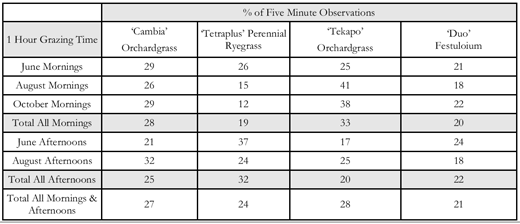Equine Grazing Preference
Published: November 14, 2008
By: University of Minnesota Extension Service
To answer this question, a horse grazing study was conducted in Ohio. Four different grass varieties; ‘Tetraplus’ perennial ryegrass, ‘Cambia’ orchardgrass, ‘Tekapo’ orchardgrass and ‘Duo’ festulolium were evaluated. The grasses were planted in a quadrant pattern in three replications in 1/3 acre paddocks.
The goal of the study was to have spring, summer and fall grazing periods with two horses per paddock, observed for one hour in the morning and one hour in the afternoon, and recording every 5 minutes which quadrant the horses were grazing.
During June morning grazing, the horses appeared to equally graze all four varieties. During the August and October mornings, the horses preferred the orchardgrasses, followed by festuloium and perennial ryegrass. When all mornings were combined, the orchardgrass varieties tended to be preferred.
During June afternoons, perennial ryegrass and festuloium were preferred, which is opposite of the June morning observations. Perhaps this is because theses grasses were not grazed in the morning or there are nutritional differences in these grass species that occur throughout the day.
During August afternoon grazing, the horses preferred the orchardgass varieties followed by perennial ryegrass and festuloium. When all afternoons were combined, the horses preferred perennial ryegrass, followed by ‘Cambia’ orchardgrass, festuloim and finally ‘Tekapo’ orchardgrass.
When all the data were combined, the orchardgrasses were preferred, followed by perennial ryegrass and festuloium.
Future research to address equine grazing preference and nutritional qualities of grass and legumes will be evaluated at the U of M Equine Center. Watch future newsletters for updates.

By Gary Wilson, Ohio State University
University of Minnesota Horse Newsletter
Source
University of Minnesota Extension ServiceRelated topics:
Recommend
Comment
Share

Would you like to discuss another topic? Create a new post to engage with experts in the community.


